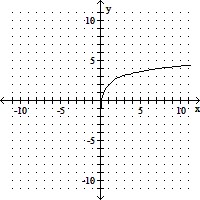Determine i) the domain of the function, ii) the range of the function, iii) the domain of the inverse, and iv) the range of the inverse.f(x) = 
A. f(x): D =  , R =
, R =  ;
;
f-1(x): D =  , R =
, R = 
B. f(x): D =  , R is all real numbers;
, R is all real numbers;
f-1(x): D is all real numbers, R = 
C. f(x): D =  , R =
, R =  ;
;
f-1(x): D =  , R =
, R = 
D. f(x): D =  , R =
, R =  ;
;
f-1(x): D is all real numbers, R = 
Answer: A
Mathematics
You might also like to view...
Graph the function.f(x) = ln x - 2 
A. 
B. 
C. 
D. 
Mathematics
Simplify using order of operations.(15 - 10)2 + (5 + 2)2
A. 144 B. 74 C. 154 D. 54
Mathematics
Provide an appropriate response.True or false? In order to graph  , the graph is the same as that of
, the graph is the same as that of  for values of
for values of  that are negative, and for nonnegative values of
that are negative, and for nonnegative values of  , the graph is reflected across the
, the graph is reflected across the 
A. True B. False
Mathematics
Perform the indicated operation. Assume that all variables represent positive numbers.
A. 
B. 2
C. 
D. 5
Mathematics